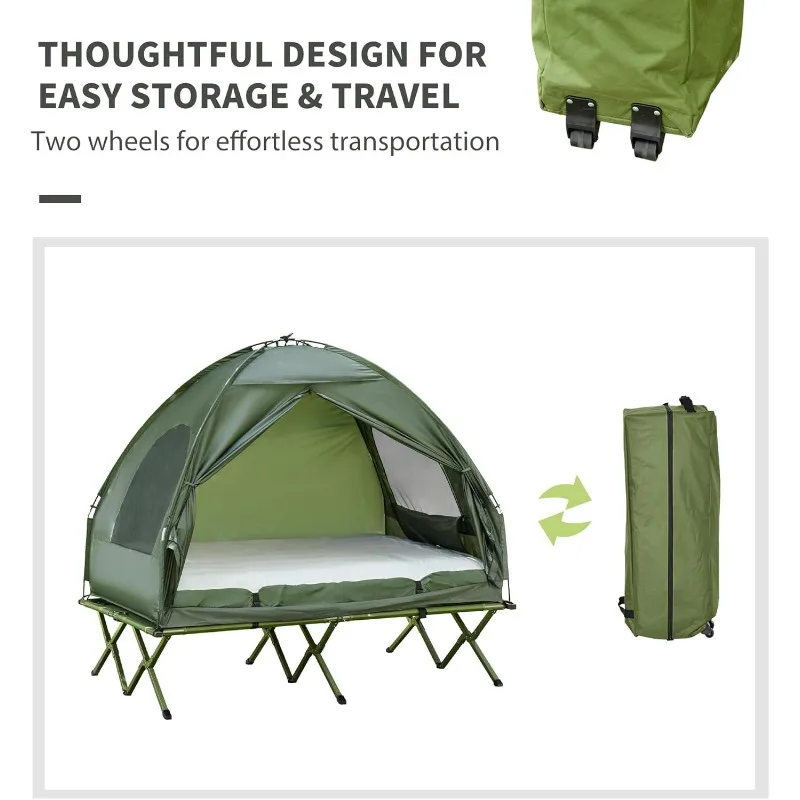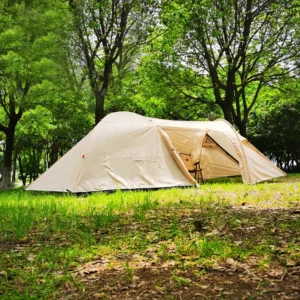Understanding Wind Resistance in Tents: The Basics
When we talk about windproof tents, we’re not discussing an absolute quality, but rather a spectrum of wind resistance. No tent is completely windproof in all conditions, but well-designed tents can withstand significant wind forces while keeping campers safe and comfortable.
Wind resistance matters for several critical reasons. First and foremost is safety—a tent that collapses in high winds leaves occupants exposed to potentially dangerous weather. Beyond safety concerns, a stable tent provides comfort during stormy conditions and prevents damage to both the tent itself and your other camping gear.
Understanding the forces at work helps explain what makes tents perform differently in windy conditions. Wind creates multiple forces on a tent: direct pressure against windward surfaces, lift over the top (similar to an airplane wing), and negative pressure on the leeward side that can cause pulling or flapping. These forces don’t increase in a simple linear fashion—doubling the wind speed actually quadruples the force exerted on your tent.
Manufacturers test wind resistance using methods like wind tunnels and extensive field testing in notoriously windy locations. While basic recreational tents might be rated for winds around 30 mph (48 km/h), expedition-grade compact shelters for two campers often withstand gusts exceeding 60 mph (97 km/h).
The principles behind wind resistance in alpine tents involve a complex interplay of features working together as a system. Let’s examine each element that contributes to a tent’s ability to stand strong when the wind picks up.
Aerodynamic Design: The First Line of Defense
The shape of your tent is arguably the most fundamental factor in determining its wind resistance. Think of your tent as an object that needs to either deflect wind efficiently or minimize the surface area that wind can push against.
Different tent designs interact with wind in distinct ways:
Dome tents: With their curved surfaces, dome tents naturally shed wind from all directions. The curved shape prevents flat surfaces from catching wind like a sail and distributes force across the entire structure.
Geodesic tents: These use triangulated pole structures to create exceptional stability. With multiple pole crossings forming small triangular panels, they represent the gold standard for wind resistance in extreme conditions.
Tunnel tents: Featuring a semi-cylindrical shape, these tents perform well when oriented correctly with their narrowest end facing the wind, but can be vulnerable from the sides.
A-frame/ridge tents: These traditional designs have flat surfaces that catch wind, making them less stable in high winds despite their simplicity.
Cabin tents: With their vertical walls and boxy shape, these family-focused designs offer excellent interior space but perform poorly in windy conditions.
Profile height plays a crucial role—taller tents catch more wind, while lower-profile designs allow air to flow more easily over the top. This is why dome camping tent designs have become so popular for outdoor enthusiasts seeking reliable performance in variable conditions.
The aerodynamic principles that make dome tent structures effective work hand-in-hand with other design elements like pole configurations and tensioning systems.
Pole Structure and Materials: The Skeleton of Strength
A tent’s pole structure serves as its skeleton, providing the framework that maintains shape and stability against wind forces. The number, arrangement, diameter, and material of poles directly determine how well a tent withstands powerful gusts.
Pole configurations that feature multiple crossover points create triangulated structures—the strongest geometric shape—resulting in superior stability. This is why geodesic and semi-geodesic designs excel in extreme conditions, as their numerous pole intersections distribute force throughout the structure rather than concentrating it at vulnerable points.
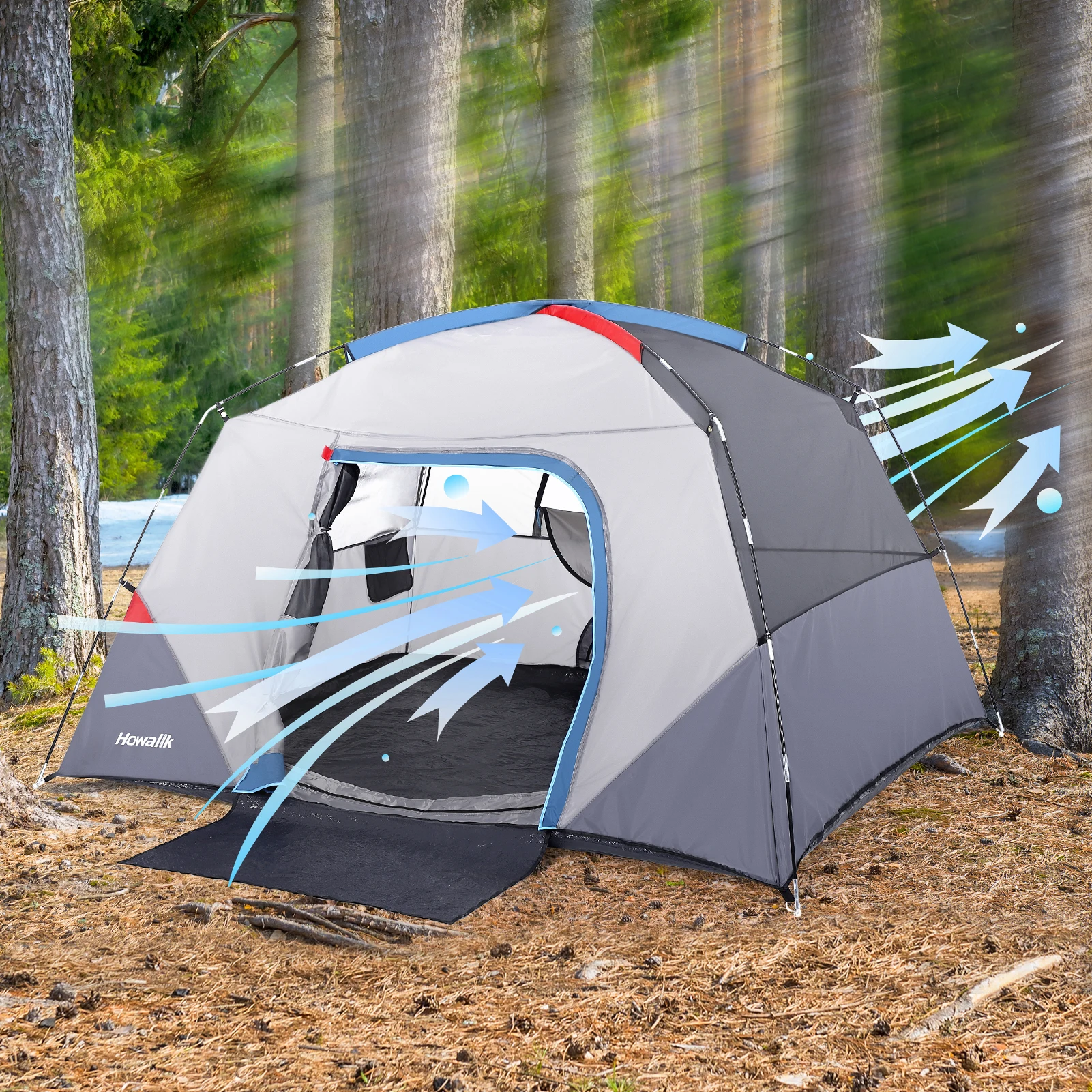
Pole materials significantly impact performance:
| Pole Material | Strength | Weight | Flexibility | Durability | Cost |
|---|---|---|---|---|---|
| Aluminum Alloy | Excellent | Light | Moderate | High | Moderate-High |
| Fiberglass | Moderate | Moderate | Good | Moderate | Low |
| Carbon Fiber | Outstanding | Very Light | Limited | High (but can shatter) | Very High |
| DAC Featherlite | Superior | Very Light | Optimized | Excellent | High |
Aluminum poles, particularly aircraft-grade aluminum alloys, offer an excellent strength-to-weight ratio and are standard in quality tents. Premium heavy duty 4-season tent models often feature specialized aluminum like DAC Featherlite or carbon fiber composites for maximum strength with minimal weight penalty.
Pole diameter also matters—thicker poles generally provide more rigidity and wind resistance but add weight. The connection between poles and fabric creates another critical consideration. Sleeve designs distribute tension more evenly along poles, while clip systems allow more flexing, each offering different benefits for wind performance.
Fabric Engineering: Materials That Stand Up to the Elements
The fabric that forms your tent’s outer shell must resist stretching, tearing, and puncturing under wind stress. Several key characteristics determine fabric performance in windy conditions:
Denier rating: This measures the thickness of individual threads. Higher denier fabrics (like 70D or greater) generally offer better durability and tear resistance than lighter options (30D or lower).
Ripstop construction: This weaving technique incorporates reinforcement threads in a grid pattern to prevent tears from spreading. When you see a grid pattern in tent fabric, that’s ripstop technology at work.
Material type: Nylon typically offers more stretch and tear resistance than polyester but absorbs water and can sag when wet. Polyester maintains its tension better in wet conditions but may have less initial strength.
Thread count: Higher thread counts create tighter weaves that resist wind penetration better.
Coatings and treatments: Silicone impregnation (silnylon) and polyurethane coatings not only improve water resistance but can enhance fabric strength.
Understanding the most durable tent material options helps you make informed decisions about the right balance of weight versus strength for your specific needs. While ultralight backpacking tents sacrifice some durability to minimize weight, waterproof camping tent models designed for harsh weather conditions typically feature more robust fabrics.
Even the strongest fabric serves little purpose without proper tension and anchoring, which brings us to our next critical element.
Guy Lines and Anchoring Systems: Securing Against Gusts
Guy lines are the unsung heroes of wind resistance. These external cords extend from attachment points on the tent to anchor points in the ground, creating a network of tension that stabilizes the entire structure.
Properly deployed guy lines:
* Prevent the tent from shifting or deforming in gusts
* Distribute wind forces away from the poles and fabric
* Create a more aerodynamic profile by maintaining the tent’s intended shape
* Reduce fabric movement that leads to noise and wear
For optimal performance, guy lines should ideally be attached at 45-degree angles from the tent. This angle provides the best balance of downward and outward force to stabilize the structure. Many 4-season winter 2-person tents feature additional guy line attachment points compared to their 3-season counterparts.
Quality guy lines feature low stretch properties even when wet, with reflective tracers for visibility at night. Tensioners or adjusters allow for quick tightening to maintain proper tension as conditions change or materials stretch.
When properly utilized, a comprehensive guy line system can dramatically improve the wind performance of almost any tent design, working in concert with stakes to create a secure foundation.
Stakes and Pegs: The Foundation of Stability
Even the best guy line system is only as effective as the stakes that anchor it to the ground. Different stake designs serve specific purposes:
Y-stakes: These provide excellent all-around holding power in most soil types through their three-pronged design that resists pulling out.
V-stakes: With their V-shaped profile, these stakes offer good holding power particularly in harder ground where penetration may be limited.
Screw/spiral stakes: These twist into the ground for exceptional holding power in loose soil like sand or soft dirt.
Snow/sand stakes: Wider and sometimes perforated, these stakes maximize surface area for grip in very soft substrates.
Titanium shepherd’s hooks: Ultralight but with limited holding power in soft ground.
Proper staking technique is just as important as stake selection. Angling stakes away from the tent (toward the direction of pull) increases holding power significantly. In very windy conditions, consider using rocks to hammer stakes deeper or to add extra weight.
Mastering proper lightweight tent setup techniques ensures you get maximum performance from your equipment when conditions deteriorate.
Seam Construction and Reinforcement Points: Preventing Weak Links
When wind batters a tent, it probes for the weakest points—and seams are often the first to fail. High-quality windproof tents feature reinforced seams and strategic strengthening at key stress points.
Critical reinforcement features include:
- Double or triple stitching at high-stress seams
- Bar tacking (dense zigzag stitching) at tension points
- Reinforcement patches at pole insertion points and guy line attachments
- Webbing or binding tape along edge seams
- Extended seam allowances that resist pulling apart under tension
Seam sealing serves a dual purpose: it prevents water penetration while also strengthening the seam itself against mechanical stress. Factory-taped seams provide the most consistent protection.
Manufacturers pay special attention to pole attachment points, usually reinforcing them with extra layers of fabric, webbing, or heavier denier material to prevent tearing under load.
Ventilation Design: Managing Airflow to Reduce Pressure
Counterintuitively, proper ventilation plays an important role in wind resistance. When a tent is completely sealed, wind passing over it creates differential pressure (lower inside than outside), which can cause the walls to pull outward or the roof to lift—similar to how an airplane wing generates lift.
Strategic venting helps equalize pressure while still maintaining weather protection. Well-designed tents feature:
- Adjustable vents positioned at both low and high points
- Mesh panels that can be covered or exposed as needed
- Vestibule designs that break up airflow
- Ridge vents that release accumulated hot air
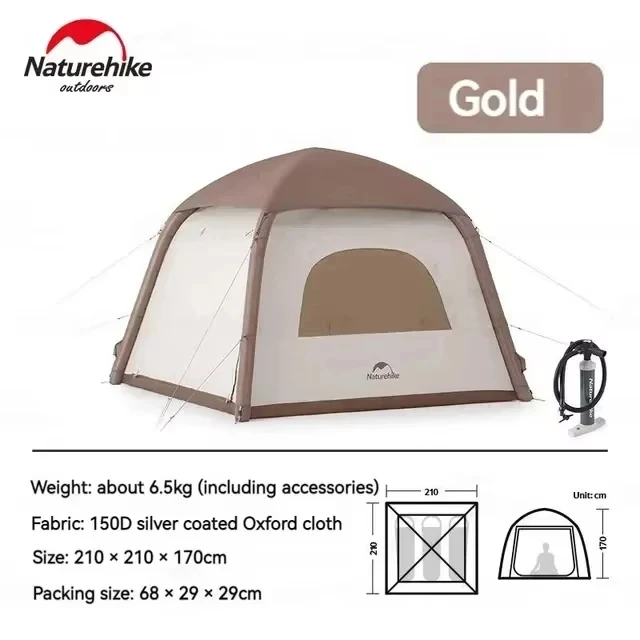
These ventilation systems work with the tent’s overall design to prevent the “ballooning” effect that can stress fabric and seams during gusts. When choosing the ultimate compact shelter for two, this balance of weatherproofing and ventilation represents a crucial consideration.
Setting Up for Success: Pitching Techniques for Windy Conditions
Even the most wind-resistant tent will underperform if improperly pitched. These techniques maximize your tent’s inherent wind-handling capabilities:
Choose your site strategically: Look for natural windbreaks like rock formations, dense shrubs, or terrain features that block prevailing winds. Avoid exposed ridgelines and wide-open spaces when strong winds are expected.
Determine wind direction: Observe flags, trees, grass, or use a weather app to identify the prevailing wind direction.
Orient your tent properly: Position the tent with its lowest, most aerodynamic end facing the wind. For tunnel tents, this means the narrow end; for dome tents, any side without a door.
Secure the windward side first: Start by anchoring the side facing the wind, then work your way around.
Use all available stake points: Many campers skip stake points in fair weather, but in wind, every attachment point matters.
Double up on critical stakes: Use two stakes in an X-pattern at critical anchor points if conditions warrant.
Maintain tension: A taut pitch with no slack fabric minimizes movement and noise in the wind.
Adjust as needed: Wind directions can shift, so be prepared to adjust your setup if conditions change.
Understanding various camping shelter options for two helps you select the right design for your expected conditions before you even begin setting up.
Heavy Duty 4 Season Tent, Mountaineering Tent, Winter Camping Tent
$870.40 Select options This product has multiple variants. The options may be chosen on the product pageCompact Backpacking Tent, Lightweight Backpacking Tent, Waterproof Camping Tent
$335.52 Select options This product has multiple variants. The options may be chosen on the product pageUltralight Backpacking Tent, Ultralight Dome Tent, Winter Camping Tent
Price range: $369.63 through $370.07 Select options This product has multiple variants. The options may be chosen on the product pageCamping Tent with Vestibule, Waterproof Camping Tent
Price range: $407.89 through $479.48 Select options This product has multiple variants. The options may be chosen on the product pageHeavy Duty 4 Season Tent, Ultralight Freestanding Tent, Winter Camping Tent
$3,722.66 Select options This product has multiple variants. The options may be chosen on the product pageBackpacking Tent with Vestibule, Trekking Pole Backpacking Tent, Waterproof Camping Tent
Price range: $271.99 through $519.52 Select options This product has multiple variants. The options may be chosen on the product page
Supplemental: Is There Such Thing as a Completely Windproof Tent?
In practical terms, no tent is completely windproof under all conditions. Even the most robust expedition tents have their limits—though those limits might exceed 100 mph (160 km/h) in some cases. When manufacturers describe tents as “windproof,” they really mean “wind-resistant to a specific threshold.”
The reality is that wind resistance exists on a spectrum, with tradeoffs between:
– Maximum wind resistance
– Portability and weight
– Cost
– Ease of setup
– Ventilation and comfort
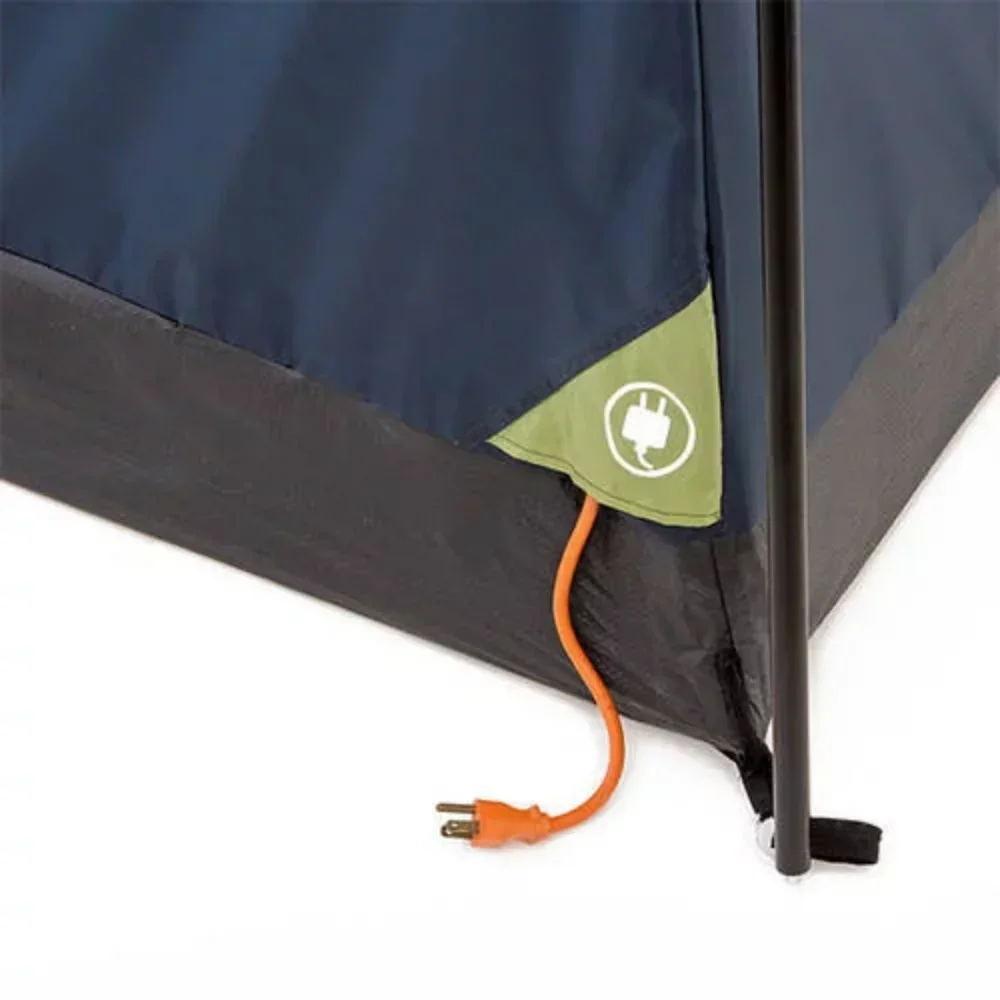
The most wind-resistant tents tend to be heavier, more expensive, and sometimes less comfortable in mild conditions due to limited ventilation. That’s why matching your tent to your expected conditions makes more sense than seeking an absolute “windproof” rating.
Here at Explore Elements, we test our tents in real-world conditions to ensure they meet or exceed their stated performance parameters. When browsing mountaineering tent options, you’ll find specific wind resistance ratings based on both laboratory and field testing.
Supplemental: How Do 3-Season vs. 4-Season Tents Compare in Wind Resistance?
The distinction between 3-season and 4-season tents reflects fundamental differences in design priorities that directly impact wind performance:
3-Season Tents typically feature:
* Lighter pole structures with fewer crossing points
* More mesh for ventilation and weight savings
* Lighter fabric (often 20-40D)
* Fewer guy-out points
* Focus on balance between weight and weather resistance
4-Season Tents usually offer:
* Robust pole structures with multiple intersection points
* Less mesh, more solid fabric walls
* Heavier fabrics (often 50-70D or higher)
* Comprehensive guy-out systems
* Lower, more aerodynamic profiles
* Design focused on weather protection over ventilation
When examining winter camping tent options, you’ll notice these structural differences immediately. The question isn’t whether 4-season tents perform better in wind (they generally do), but rather whether you need that level of protection for your intended use.
A well-designed 3-season tent properly pitched can handle most conditions campers typically encounter during spring, summer, and fall. However, for winter expeditions, alpine environments, or areas known for extreme weather, the additional features of 4-season tents provide critical protection worth their weight penalty.
Understanding these design elements helps you make informed choices about the right tent for your specific camping needs—balancing weight, cost, and weather resistance for your unique adventures.

